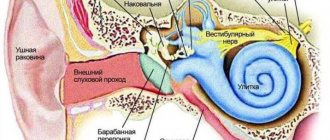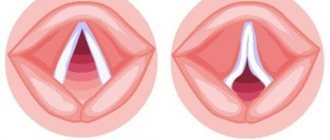False croup - symptoms and treatment
The goals of treatment for croup are to restore respiratory function as quickly as possible, improve the patient’s condition, and prevent the progression of laryngeal stenosis and the development of obstructive tracheobronchitis [25].
Conservative treatment
According to international consensus, as well as recommendations of the World Health Organization (WHO), the basis of treatment for false croup is inhaled and systemic glucocorticosteroids (GCS) - anti-inflammatory drugs [16]. In the Russian Federation, when treating croup, priority is given to the administration of nebulized budesonide, an inhaled corticosteroid for topical use.
For 1st degree laryngeal stenosis, inhalation administration of a budesonide suspension through a compressor nebulizer is indicated. In 85% of cases, 1 procedure is sufficient; if necessary, inhalations are repeated 2 times a day until the stenosis is completely resolved. The drug has fewer side effects than systemic corticosteroids, which affect the entire body. Budesonide reduces edema, mucus production, sputum production, and airway hyperresponsiveness.
First-line drugs for grade 2 stenosis or if budesonide is ineffective for grade 1 stenosis are dexamethasone or prednisolone, which are used in tablet form or administered intramuscularly/intravenously [17].
To reduce the severity of symptoms in children, low-dose prednisolone and dexamethasone may be as effective as standard-dose medications [18].
In severe croup, as well as in the absence of corticosteroids or ineffective treatment with dexamethasone (prednisolone), inhaled epinephrine (adrenaline) is possible [25]. The mechanism of action involves vasoconstriction in the mucous membrane of the upper respiratory tract, which leads to a decrease in edema [19]. Epinephrine has a rapid but unstable effect (no more than 2 hours), so it should not be used as monotherapy. In Russia, this method is not used as often as in European countries [16].
Table 1 - Algorithm for providing medical care to children with acute stenotic laryngotracheitis (false croup) depending on the degree of stenosis.
| I degree (less than 2 points) | II degree (3-7 points) | III degree (more than 8 points) |
| — Emotional and mental peace — Access to fresh air — Comfortable body position for the child — Distraction procedures — Humidified air — Antipyretic therapy according to indications — Monitoring respiratory rate, heart rate, pulse oximetry | — Hospitalization in the intensive care unit (ICU) or intensive care unit (ICU) — If pulse oximetry is less than 92% — humidified oxygen — Dexamethasone or prednisolone intramuscularly — Inhalation of budesonide through a nebulizer until laryngeal stenosis is relieved; when the condition stabilizes, reduce the dose of the drug - Reassessment of symptoms after 20 minutes - According to indications - intubation/tracheostomy | |
| — Inhalation of budesonide through a nebulizer with saline; when the condition improves - every 12 hours until laryngeal stenosis is relieved - Reassessment of symptoms 15-20 minutes after inhalation | — Calling an emergency medical team, emergency hospitalization — Inhalation of budesonide through a nebulizer until laryngeal stenosis is relieved; when the condition stabilizes, reduce the dose of the drug - Dexamethasone or prednisolone intramuscularly | |
| If there is no effect from inhalations: - Dexamethasone or prednisolone intramuscularly - Hospitalization | If there is no effect and/or saturation decreases to less than 92%, transfer to the ICU or ICU | |
Oxygen. The supply of humidified oxygen is indicated for respiratory failure. In Europe and America, a mixture of helium and oxygen (heliox) is also used. Due to the decrease in gas density, such a mixture is easier to inhale [20].
Exposure to cold air. There are no studies showing the effectiveness of this method, but parents often report improvement in croup symptoms when exposed to cold air. For example, if you open a window in cold weather, take the child outside or onto the balcony. In warm weather, parents sometimes bring their child to the open freezer door.
Antipyretic. May be used to reduce discomfort associated with fever. Aspirin is contraindicated in children with viral infections due to the increased risk of developing Reye's syndrome (acute liver failure and brain damage). The drugs of choice are acetaminophen (paracetamol) and ibuprofen (Nurofen), but it is also possible to use a combination of them (Ibuklin).
Antibiotics. Used only for false croup, which is caused by bacteria. The antibiotic is selected based on the suspected bacterial pathogen. After receiving the results of the analysis for the pathogen, the drug is changed if necessary.
Antiviral drugs. If influenza is detected, a neuraminidase inhibitor may be prescribed.
Other medications are used according to indications: for gastroesophageal reflux (GER) - antireflux drugs, for allergies - 2nd generation antihistamines [22].
Surgery
In uncomplicated cases of croup, surgical treatment is not required. intubation is required , which involves inserting an endotracheal tube into the trachea to ensure airway patency [16].
In case of asphyxia (suffocation) and the impossibility of intubation, a tracheostomy - dissection of the tracheal cartilage to create a temporary anastomosis with the environment. It may also be required to remove a foreign body [16].
Laryngoplasty (plastic reconstruction of the larynx) is indicated for recurrent croup if pathological conditions such as stenosis, cyst or tumor are identified.
What parents should know about cereals
Authors : American Academy of Pediatrics
Croup is common in childhood. And when an attack occurs for the first time, it frightens both children and parents. Below we will talk about the types of croup, causes, symptoms and treatment methods.
What is croup?
Without details and terms, croup is swelling and narrowing of the larynx and trachea caused by infectious diseases. The lumen of the airways narrows, and difficult noisy breathing occurs.
Croup usually occurs in children between 3 months and 5 years of age. When they get older, this does not happen so often - the larynx and trachea also grow, the lumen increases, and swelling no longer causes difficulty breathing. Swelling due to a respiratory tract infection can happen at any time of the year, but is more common in the fall and winter months.
Types of croup
Viral croup
Viruses whose favorite breeding sites are the larynx and trachea cause the most common type of croup - viral. It starts out like a normal ARVI, then the voice becomes hoarse, a barking cough and difficulty breathing appear. Normally, a person’s breathing is silent, and if anything is heard - sniffling, squeaking, grunting, etc. - this is called stridor. Typically, viral croup is not accompanied by a high temperature, but sometimes it can reach 40 C.
Spasmodic croup
This type of croup is believed to be caused by allergies or gastroesophageal reflux disease (GERD). It occurs suddenly, usually at night. A child can go to bed absolutely healthy and suddenly wake up a few hours later because he cannot breathe, with a hoarse voice, stridor, and sometimes a barking cough. Most children with spasmodic croup do not have a fever. It is this type of croup that can recur. Symptoms similar to those of asthma are usually due to allergies or reflux.
Croup with stridor
Stridor (breath noise) usually accompanies mild forms of croup. Stridor is especially worse during crying or physical activity. But if a child's breath sounds can be heard even at rest, this may be a sign of a more severe form of croup. As the condition worsens, the child may stop eating and drinking, or simply get tired of coughing, and you will hear the breathing become more noisy and strained with each breath.
The danger with croup with stridor is that sometimes the swelling of the airways can be so severe that the child can barely breathe. In such cases, be sure to seek medical help. Fortunately, such severe forms of croup are rare.
Basics in the treatment of croup
If your child wakes up in the middle of the night with signs of croup, try to remain calm yourself and calm your baby - this will help him breathe more smoothly.
To calm your child, try:
- hug him and stroke his back;
- sing your favorite lullaby;
- tell him: “Mom is here, everything will be fine”;
- offer your favorite toy.
If the baby has a temperature of 38°C or higher, give paracetamol or ibuprofen (for children over 6 months). Don't forget that if you have a fever, you need to drink plenty of fluids and make sure you don't get dehydrated.
Sometimes doctors advise taking a choking child to the bathroom and breathing in the steam from the hot water. Many parents note that this really helps improve breathing. But there is not a single authoritative study proving the effectiveness of this method or the positive effect of damp and cold night air on breathing in croup.
When you need a doctor
If your child's croup does not improve, seek medical attention immediately.
You need a doctor urgently if:
- the child has wheezing that becomes louder with each breath;
- the child cannot say anything due to the inability to take a breath;
- it seems that the child is struggling to catch his breath;
- the child's lips or nails turn blue;
- there is pronounced stridor at rest;
- Drooling flows uncontrollably, and the child cannot swallow it.
Treatment of croup with medications
If a child has viral croup, the pediatrician or emergency physician may prescribe adrenaline (epinephrine) to reduce swelling of the larynx, and then monitor the child for 3 to 4 hours to ensure that symptoms of croup do not recur.
To reduce swelling, hormonal (steroid) medications may be prescribed orally, by inhalation, or by injection. Treatment with several doses of hormonal drugs will not do any harm, but they will reduce the intensity of symptoms and the need for other drugs, as well as the time spent in the hospital. For spasmodic croup, your pediatrician will prescribe allergy or reflux medications to quickly restore your baby's normal breathing.
Antibiotics, which only affect bacteria, are not effective in treating croup, which is most often caused by a virus, allergy, or reflux. Cough syrups will also not have a positive effect and may even be dangerous.
Other infections
Another cause of stridor and difficulty breathing can be acute epiglottitis. The symptoms of this dangerous infection, which is usually caused by bacteria, are similar to those of croup. Fortunately, this infection is now less common thanks to mass vaccination against Haemophilus influenzae type b (Hib). Other bacteria rarely cause epiglottitis.
Acute epiglottitis most often affects children aged 2 to 5 years and occurs suddenly, starting immediately with a high fever. Typically, a sick child sits with his chin raised - in this position it is easier for him to breathe; hoarseness of voice and increased salivation are also observed. If epiglottitis is left untreated, the infection can quickly lead to complete blockage of a child's airway.
If your child's pediatrician suspects acute epiglottitis, seek qualified medical attention immediately. Once the diagnosis is confirmed, treatment with antibiotics will be necessary, and intubation may be necessary to help the child breathe.
To protect the child from acute epiglottitis. vaccinate him according to the vaccination schedule. The Hib vaccine protects not only against epiglottitis, but also against meningitis. After the advent of the Hib vaccine, the number of cases of acute epiglottitis and meningitis decreased sharply.
Intermittent or constant cereals
Frequent recurrences of croup in a child may be a sign of airway obstruction (narrowing) not related to infection. The causes of this disease can be either congenital or acquired. To further assess the child’s condition, the pediatrician will refer you for a consultation with a specialist: an otolaryngologist (ENT doctor) or a pulmonologist (a specialist in diseases of the lungs and respiratory tract).
Croup is a truly common illness in childhood. In most cases, croup is mild, but it can be severe. Contact your pediatrician if your child's croup does not improve or if you have questions. The pediatrician will prescribe the necessary examination and treatment.
Source
published 03/02/2015 14:49 updated 13/01/2019 — acute respiratory infections, Allergic diseases, Infectious diseases, Miscellaneous
Diagnosis of croup
During diagnostic measures, a specialist determines the etiology and form of the disease, after which effective therapy is selected. Using a laryngoscope or pharyngoscope, the ENT examines the nasopharynx. In addition, the submandibular areas are palpated to exclude possible neoplasms and foreign objects in the pharynx. Also, the patient must donate blood for analysis.
To make a correct diagnosis, a specialist may prescribe a number of additional diagnostic procedures. Usually prescribed:
- endoscopic examination;
- tracheobronchoscopy using special video equipment;
- ultrasound examination (thyroid gland);
- magnetic resonance or computed tomography of the larynx;
- a test that examines a swab from the throat.
The specialist uses the results obtained to determine the degree of development of the disease and select the most effective treatment for false croup in children.
Actions at the first symptoms of false croup
If you suspect false croup in your baby, you should immediately call an ambulance. First aid for false croup, until the ambulance arrives, should be the following:
- open the windows in the room or car, providing access to fresh air to the patient;
- free the child from clothes that are constricting the chest and throat;
- put vasoconstrictor drops into the child’s nose;
- do inhalations (saline), if it is not possible to do inhalations with false croup, you can breathe in hot steam from a saucepan or emanating from a stream of hot water from a tap in the bathroom;
- provide the baby with the amount of drinking water he needs, but do not force him to drink a lot to avoid vomiting;
- if there is a fever, give an antipyretic;
- if the child stops breathing, press on the root of the tongue, thereby causing vomiting;
- Give antihistamine tablets to reduce swelling.
Causes of croup
Most often, the disease is infectious in nature and occurs when bacteria, viruses or fungi enter the child’s respiratory tract.
Pathogens settle on the larynx when contaminated air is inhaled, causing an inflammatory process in the respiratory tract. Croup syndrome can develop against the background of acute respiratory viral infections, influenza, measles, chickenpox, or when infected with staphylococcal, streptococcal infections, as well as Haemophilus influenzae. The allergic form of croup occurs in children with allergic reactions to external irritants (pollen, animal hair, dust mites, cosmetics, medications, etc.). True croup occurs when infected with diphtheria bacillus. Normally, a healthy body is able to independently overcome an infection that has entered the respiratory tract. The occurrence of inflammation is preceded by a decrease in the immune forces of the child’s body. A similar situation can arise with hypothermia, vitamin deficiency, the presence of chronic diseases, and frequent contact with patients. At a younger age, low birth weight children, children who have suffered from hypoxia, birth injuries, or those suffering from rickets are susceptible to croup.
False croup in children
The diagnosis of “false croup” is made by a pediatrician based on a visual examination of the child’s larynx and listening to the lungs with a stethoscope. Since treatment must be prescribed and measures taken immediately, there is no time to wait for test results.
An experienced doctor can diagnose the etymology of false croup (whether it is viral or bacterial) without special equipment and laboratory measures, such as rhinoscopy, x-ray, etc. All these measures will be needed to diagnose possible complications after false croup.
How to recognize false croup in a child at the onset of the disease? False croup develops against the background or after ARVI or influenza. An attack of false croup usually begins in the evening or even in the middle of the night, with a barking cough, accompanied by wheezing, difficulty breathing. The child’s nasolabial triangle becomes bluish in color, the voice becomes hoarse or disappears altogether. The child is frightened, breathing quickly and shallowly.
In infants, the symptoms of false croup are the same as in older children, however, if not treated in a timely manner, the outcome of this disease in infants can be fatal, as it progresses more quickly. If the swelling of the larynx is not removed, the baby may die from asphyxia (suffocate).
Many parents wonder: is it possible for a child to walk with false croup? If the child does not have a fever and if you do not communicate with peers so as not to infect them, then you can and should go for a walk. Fresh air is healing and speeds up recovery. Another common question from parents is: at what age can a child develop false croup? We answer – up to 7 years. After 7 years of age, due to anatomical features, the child is less likely to develop false croup.
False croup in adults
In adults, the diagnosis of “false croup” is made by an otolaryngologist based on the clinical picture typical for this disease. As an option, if in doubt, a throat smear and microlaryngoscopy are performed to identify and determine the causative agent of the disease. A number of specific laboratory tests can determine whether the croup is viral or bactericidal. A general analysis, acid-base blood test and blood gas analysis determine the severity of hypoxia - an indispensable component of false croup.
Classification of false croup
There is a gradation of this disease into viral and bactericidal croup - it all depends on the cause of its occurrence (etiology). If, in addition to signs of croup, there are signs of other concomitant diseases, this is complicated croup; if not, it is uncomplicated. There is a classification of croup according to the degree of stenosis (narrowing) of the larynx:
1st degree – compensated;
2nd degree – subcompensated;
3rd degree – decompensated;
Grade 4 – the most severe, hypoxia.










